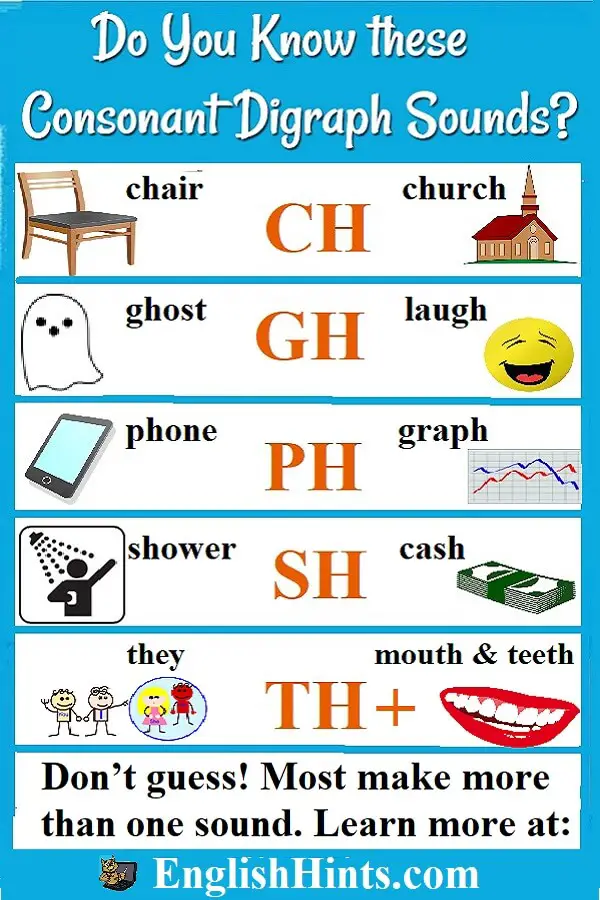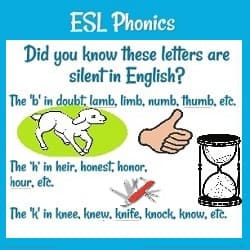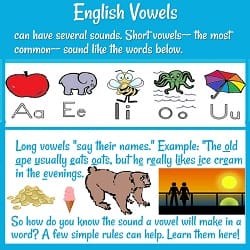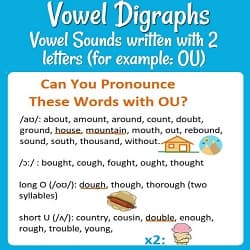9 Consonant Digraphs You Need to Know
Learning these consonant digraph sounds will improve your reading, pronunciation, and spelling. These letter combinations are very common. The complication is that their pronunciation is nothing like their individual letter sounds. Look through them, and also notice the most common words they form.
English spelling can be very strange. Sometimes words keep part of the spelling of the language they came from. Often one sound can be written several ways.
The good news is that there are patterns to English spelling. Learn the patterns shown on this page, ESL Phonics , Short and Long English Vowels, and English Vowel Digraphs. Then you should be able to recognize and pronounce most common English words.
Common Consonant Digraph Sounds
Digraphs are letter combinations that make a single sound.
The digraphs listed here make sounds different from the individual letter sounds blended together.
CH, GH, PH, SH, TH, & WH
1. CH makes three sounds in English: most commonly /tʃ/: chair, child, church, & catch, march, watch.
It also makes a /k/ sound in words of Greek origin: character,
Christian, chorus, chronological.
Sometimes it has the /ʃ/ (‘sh’) sound in words of French origin like champagne or machine.
2. GH is pronounced /g/ at the beginning of words like ghost. At the end of words it is silent (see below) or makes the /f/ sound: cough, enough, laugh, rough, tough.(The last two are pronounced 'ruff' & 'tuff.' See also PH.)
It is silent in bought, caught, daughter, height, high, light, might, right, sigh, sight, though, and thought (etc.).
3. PH makes the sound of /f/: graph, phone, phonics.(The ending sound is exactly the same in graph, half, laugh, and staff.)
4. SH makes the /ʃ/ sound: cash, fashion, foolish, rash, shame, shelter, should, shower, trash, wash.
5. TH makes 2 related sounds: /θ/ (voiceless): anything, author, bath, breath, cloth, health, teeth, nothing
or /ð/ (voiced): breathe, brother, clothing, father, mother, mouth, southern, teethe, than, that, the, their, them, then, there, these, they, this, those, though, thus, together, weather.
6. WH makes the sound of /hw/: what, when, where, which, why (or an /h/ sound in who or whole.)
KN, NG, & QU
7. KN makes the sound of /n/: knee, knew ( pronounced just like 'new'), knife, knight, or know (which sounds exactly like 'no'.)
8. NG makes the /ŋ/ sound: bang, king, long, lung, ring, sing.
9. QU makes the sound of /kw/: quality, question, quick, quiet.
You Might Also Like:
ESL Phonics lists the basic sounds of each letter, with examples.
Learn the basic rules to recognize which sounds English vowels will make in different words.
Learn the sounds different vowel digraphs (like ai, au, ea, oo, or ou) make.
They all can help you pronounce what you read-- or spell what you can say.
Didn't find what you
needed? Explain what you want in the search box below.
(For example, cognates, past tense practice, or 'get along with.') Click to see the related pages on EnglishHints.
| site search by freefind | advanced |










New! Comments
What do you think about what you just read? Leave me a comment in the box below.